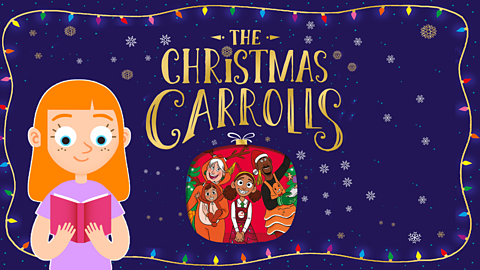What is the book about?
This guide is produced in partnership with Blue Peter
Major and Mynah written by Karen Own and illustrated by Louise Forshaw is the eleventh book in the Blue Peter Book Club.
Callie's nervous about her new hearing aids, 'the Slugs', but when she discovers they let her chat with Bo the Mynah bird, her worries fade away. With Bo's keen eyes, the trio - alongside Callie's best friend Grace - embark on a mission to catch a mischievous thief wreaking havoc in town. Are you ready to join SPUD, the Super Perceptive Undercover Detectives, on their first adventure?
You can get a sneak peek of the book over on Blue Peter.
Callie has brand new hearing aids but isn't sure she entirely loves wearing them.
That is until she discovers that with them comes a super skill.
Being able to communicate with a mynah bird called Bo!
Soon Callie and her pal, Grace find themselves working with their new feathered friend to try and catch a local thief!
How are capital letters used for emphasis?
Did you spot that some words in the story were written in capital letters? Did you also notice that they were presented in a different way too? Perhaps a different fontWhat the text (writing) looks like. or size?
Throughout Major and Mynah, capital letters have been used to emphasiseMaking something standout so that people pay attention to it. important parts or sounds within the story.
Take a look at this example from page 24.

When a word is emphasised it stands out, so that you can really pay attention to it! This makes the writing more interesting and exciting to read, whilst also making sure you know what is important.
Here are some more examples:
- 'Mum huffed and puffed and said everyone was going to be late unless she found them IMMEDIATELY.' (page 10)
Using capital letters here makes it clear that mum needed to find the swimming trunk very quickly!
- 'Bo hadn't eaten just one or two of Dad's blackcurrants. Or even three or four. He'd eaten ALL of them.' (page 90)
As capital letters have been used to emphasise the word ALL here, it is clear that Callie is shocked that Bo has eaten so many blackcurrants!
In the image below, capital letters have been used alongside a different font to emphasise the SPLODGE shape of Bo's blackcurrant-coloured poo!

How have images been used to help tell the story?
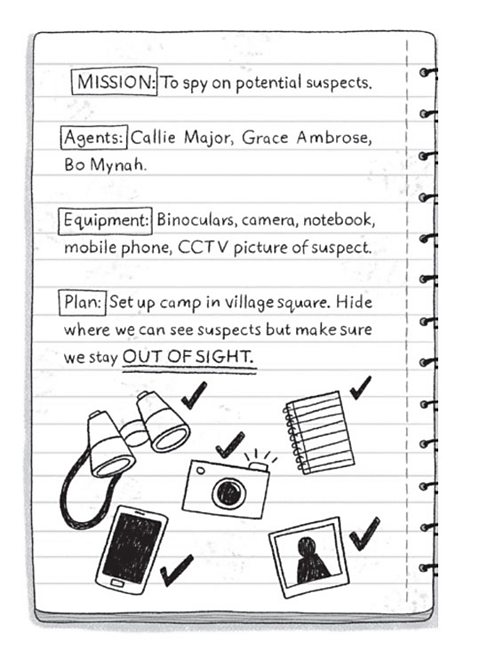
Did you like the imagesPictures that help tell the story. throughout Major and Mynah? Images are used to help move the story along and give you extra detail as you read.
The 'SPUD' notebook images throughout the story are very effective. The information contained in these images give you more detail about what the characters are doing and thinking.
These images also offer you a different view of the story.
Most of the story is told from Callie's perspectiveThe point of view from which the story is told (who is telling the story).; however, seeing the SPUD notebook pages make you feel like you are part of the Super Perceptive Undercover Detectives (SPUD) with both Callie and Grace!
Take a look at this example from page 68.
Using this image of the notebook is a quick way of grabbing your attention to tell you what the SPUD team are going to do. Adding a drawing alongside the writing also makes it more interesting for you to read.

What is a 'plot twist' and how has it been used?
What changes did you notice in Major and Mynah that you didn't expect? Perhaps, it was Callie's ability to talk to a bird or how SPUD worked to solve the case.
When something unexpected happens in a story, we call this a .
Plot twists are used to surprise and engage you as you read.
In Major and Mynah one of the big plot twists is how Callie's opinion of her hearing aids (aka her 'slugs') changes as the story moves on.
At first, Callie clearly doesn't like her hearing aids:
'I hate the hearing aids. From now on I'm going to call them THE SLUGS because it feels like slugs have crawled into my ears and got stuck.' (page 26)
However, as the story moves on a plot twist happens…Eventually, Callie grows to like and value her hearing aids, especially when she realises that she can use them to communicate with Bo.

What are inverted commas and how have they been used?
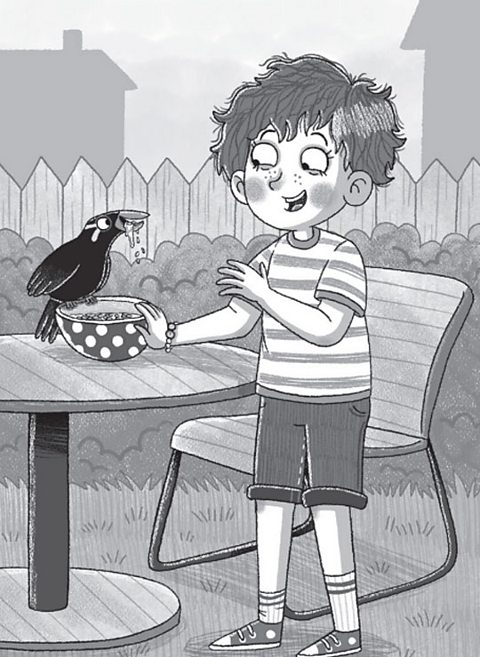
Speech between characters is an important part of any story that helps to move it along. Speech can be used to show excitement, fear, and different feelings or even add detail - it is essential in any story!
In Major and Mynah, speech is particularly important because it clearly shows the conversations that Callie and Bo have with each other. As, we know, Callie's ability to talk to Bo is one of the main parts of the whole story!
But, how can you tell what is speech and what isn't?
Speech is shown using punctuation called (sometimes people might call these speech marks).
When you are writing, inverted commas go before and after direct speech, surrounding what was said.
"That was a lucky escape," said Grace.
If another character replies, use another set of inverted commas.
"I'm not very good at being wild," replied Bo.
Punctuation, such as question marks, full stops and exclamation marks go inside the speech marks.
To learn more about inverted commas watch the video on this KS2 Bitesize guide.

Quiz
Activity 1
Remember that inverted commas surround the words that a character is saying.
For each sentence, can you re-write the sentence adding inverted commas for the speech.
- You're safe now, said Callie.
- Mum shouted, Time to go.
- And can you hear me! the bird replied.
- I whispered, What are you talking about?
- You've scared him no! I huffed.
Answers
- "You are safe now," said Callie
- Mum shouted, "Time to go."
- "And can you hear me!"the bird replied.
- I whispered, "What are you talking about?"
- "You've scared him now!" I huffed.
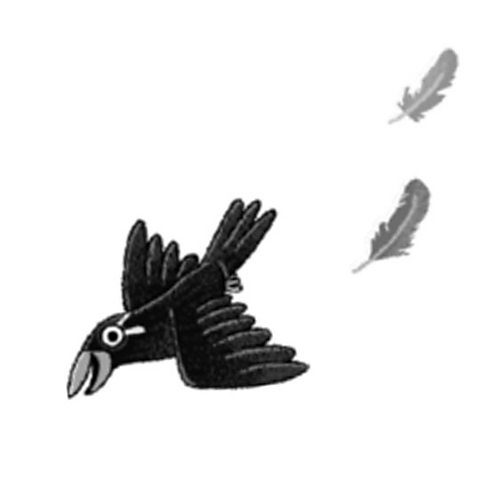
Activity 2
It's time to get your imagination working! A plot twist is when something unexpected happens in a story. This is usually a big change from the start of the story compared to the end. For example, how Callie's love of her hearing aids grows in Major and Mynah.
Your challenge is to think of a new plot twist for the story.
Write down your ideas and remember to explain them. Once you're finished, share your ideas with someone at home or someone you know who has read the book too.
Struggling for ideas? Here's an example…
When Callie first meets Bo he's very friendly and they get on well. HOWEVER, a good plot twist could be that Bo is in fact working for the bike thief by flying around the town looking for bikes that are easy to steal!

More on Blue Peter Book Club
Find out more by working through a topic
- count1 of 12

- count2 of 12
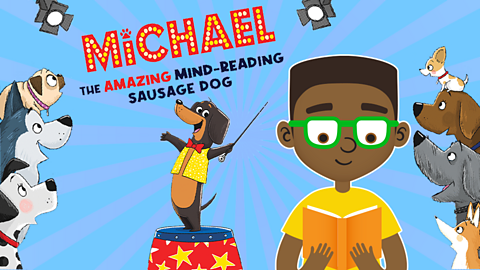
- count3 of 12
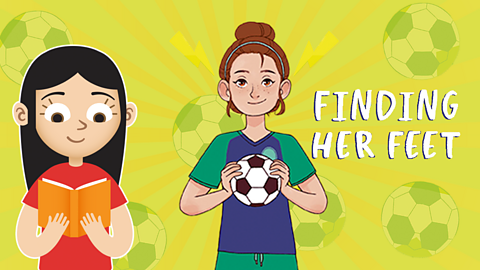
- count4 of 12
